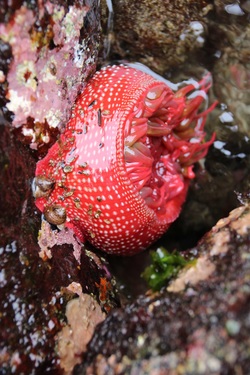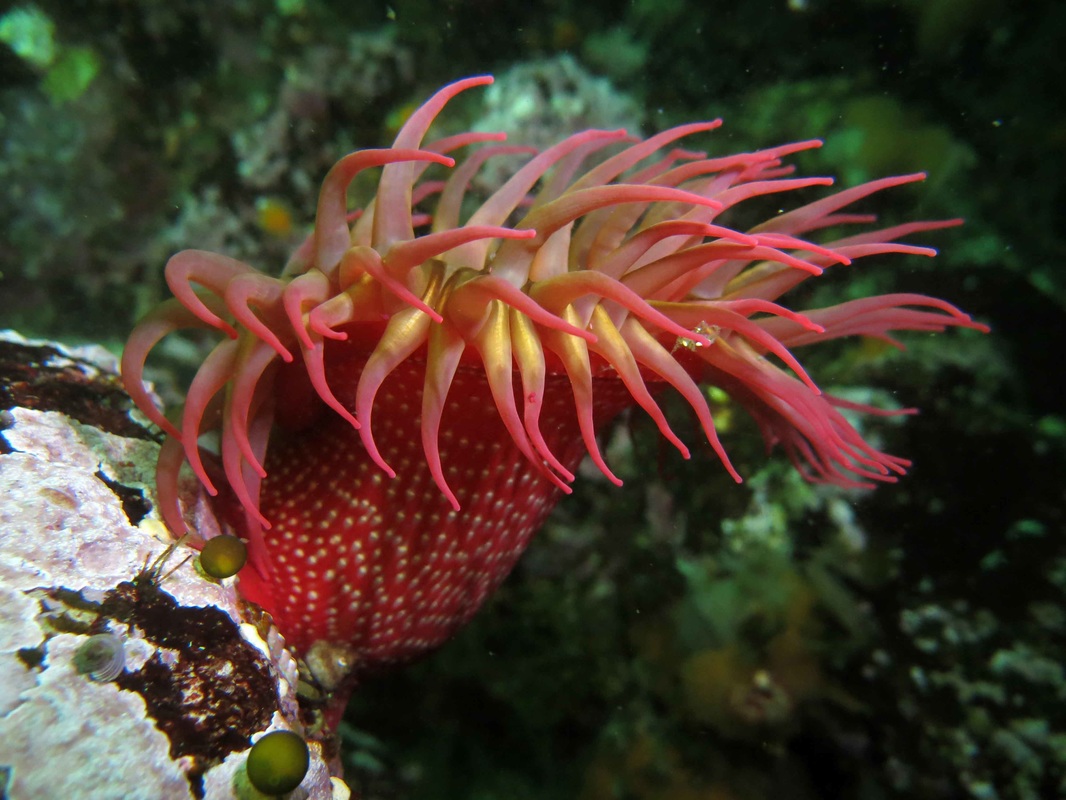White-spotted rose anemone • Cribrinopsis albopunctatus
Identification
The white-spotted rose anemone has a stout dark red to reddish-pink column marked by many white spots (smooth papillae) aligned in vertical rows. The column colour may vary - it is occasionally lighter pink or almost white - but the vertical lines of white spots are a key distinguishing feature. The tentacles are long and slender, with yellow-tinged bases and pinkish tips. This species grows to 15 cm in diameter as well as in height.
Habitat & Range
The white-spotted rose anemone is mainly a subtidal species, though it can be found in low intertidal areas. It attaches to rocks, pilings, and floats in the subtidal; in the intertidal it is most often found attached to vertical rock faces and in surge channels. It inhabits outer exposed coastlines from northern Alaska to southern California.
Intriguing Info
This species is often incorrectly called Urticina lofotensis - this name is actually a synonym for an Atlantic species, the valid name for which is Urticina eques. Click here for more information.
The white spots are actually sticky tubercles and may have shell fragments and sediment stuck to them.
The painted greenling (Oxylebius pictus) is often found sheltering near this species, and at night may be found sleeping at the column base
iNaturalist
https://www.inaturalist.org/taxa/508023-Cribrinopsis-albopunctata
The white-spotted rose anemone has a stout dark red to reddish-pink column marked by many white spots (smooth papillae) aligned in vertical rows. The column colour may vary - it is occasionally lighter pink or almost white - but the vertical lines of white spots are a key distinguishing feature. The tentacles are long and slender, with yellow-tinged bases and pinkish tips. This species grows to 15 cm in diameter as well as in height.
Habitat & Range
The white-spotted rose anemone is mainly a subtidal species, though it can be found in low intertidal areas. It attaches to rocks, pilings, and floats in the subtidal; in the intertidal it is most often found attached to vertical rock faces and in surge channels. It inhabits outer exposed coastlines from northern Alaska to southern California.
Intriguing Info
This species is often incorrectly called Urticina lofotensis - this name is actually a synonym for an Atlantic species, the valid name for which is Urticina eques. Click here for more information.
The white spots are actually sticky tubercles and may have shell fragments and sediment stuck to them.
The painted greenling (Oxylebius pictus) is often found sheltering near this species, and at night may be found sleeping at the column base
iNaturalist
https://www.inaturalist.org/taxa/508023-Cribrinopsis-albopunctata
References
Cowles, D. (2006). Urticina lofotensis (Danielssen, 1890). Invertebrates of the Salish Sea. Rosario Beach Marine Laboratory. Accessed 07/11/2014.
Harbo, R. M. (2011). Whelks to whales: Coastal marine life of the Pacific Northwest (Revised). Madeira Park, BC: Harbour Publishing. P. 61
Lamb, A., and Hanby, B. (2005). Marine Life of the Pacific Northwest [electronic version]. Madeira Park, BC: Harbour Publishing.
Sanamyan, N.P., Sanamyan, K.E., and Schlories, D. Cribrinopsis albopunctata Sanamyan et Sanamyan, 2006. Actinaria.com. Accessed 07/11/2014.
Authors and editors of page
Kelly Fretwell and Brian Starzomski (2014).
Cowles, D. (2006). Urticina lofotensis (Danielssen, 1890). Invertebrates of the Salish Sea. Rosario Beach Marine Laboratory. Accessed 07/11/2014.
Harbo, R. M. (2011). Whelks to whales: Coastal marine life of the Pacific Northwest (Revised). Madeira Park, BC: Harbour Publishing. P. 61
Lamb, A., and Hanby, B. (2005). Marine Life of the Pacific Northwest [electronic version]. Madeira Park, BC: Harbour Publishing.
Sanamyan, N.P., Sanamyan, K.E., and Schlories, D. Cribrinopsis albopunctata Sanamyan et Sanamyan, 2006. Actinaria.com. Accessed 07/11/2014.
Authors and editors of page
Kelly Fretwell and Brian Starzomski (2014).






